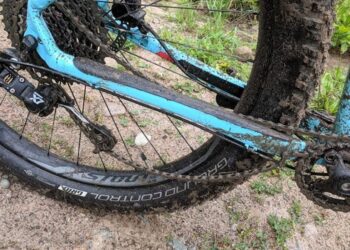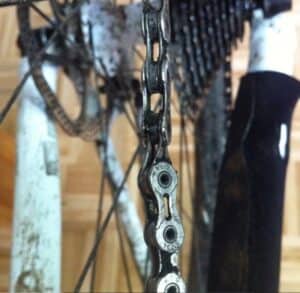There are many ways in which a chain can get stuck. Probably the most common one is chain getting stuck between chainrings and frame. For those that confuse chainrings with cogs, a chainring is a set of cogs on the crankset in bicycle terms. In recent times, chainrings and crankset became somewhat a synonym.
Why does a chain get stuck between chainrings and the frame?
A chain gets stuck between the crankset and frame for lots of reasons. However, the most common ones are the derailleur being poorly adjusted, small sprocket being bent, teeth being bent, the chain having a stuck link, or the chain being bent.
For these and a few more reasons, a chain can fall off the small sprocket and fall inside the crankset and frame gap.
Difference Between Chain Falling off Once or Multiple Times
A chain may fall off once, and never again. In that case, there might or might not be anything wrong with your bike. Some derailleurs, especially older ones, don’t really have the best tension on the rear, or the best cage up front to retain the chain from ever falling off. Specifically, I’m speaking of mountain biking because riding off-road tends to make the chain fly around a bit and challenge the drivetrain’s capabilities.
If, however, the chain keeps falling off, there might be some significant issues with the bike’s adjustment and functionality. I will do my best to explain each scenario that I’ve personally encountered and found solutions for, including road bikes.
A Chain Can Also Fall off the Chainrings on the Outside
A chain falling off the chainrings on the outside means it fell off from the biggest sprocket, down to the pedal. Usually happens when shifting into the biggest sprocket.
Why do I include this in the article?
Because the reasons related to the derailleur adjustment and anything being bent are pretty much the same for both cases, I don’t find it necessary to write a whole new article to talk about this problem as well.
What Is Chain Suck and What Causes It?

I decided to mention this because chain suck results in the chain getting stuck between chainrings and frames in lots of bikes. However, in a different place, more accurately, between chainrings and the right chainstay.
How to Unstick the Chain
I’ve managed to unstick the chain from there before, more often than I’d like to admit.
Usually, you can wiggle the chain free, though it does take some force and may damage the paint. I would create some slack on the chain first. You can achieve this by moving the derailleur forwards. It’s important to do this; otherwise, it will pull back on the chain you are trying to free up.
It would be best to remove the smallest cog, which is right next to the frame. That one has four bolts of its own holding it on, accessible on the small ring’s inboard side. You can easily remove the bolts one at a time while the crank is still on the bike. It should allow enough play in the cog itself to pull the chain out of there. This is the first thing I usually do, but if you can’t rotate the crank to access enough bolts, you might have to try something else.
So that leaves us with option 2, removing the crank. Cranks don’t come off on their own just by taking the bolt out. Removing the whole crank needs a cotterless crank puller tool. Bike Hand Crank Puller will do the job perfectly, and it doesn’t require an extra wrench to work with it. The tool is quite simple to use. Screw the bigger thread in the crankarm and then screw in the thinner part of the tool, which will push onto the axle. With the right tool and knowledge available, you’d probably do this right away.
Remember to tighten all the bolts again. It’s an excellent opportunity to remove any rust from them. You can add a bit of grease to each of them.
If the chain keeps falling off the inner chainring, you might want to check it out. Maybe a tooth is bent, or the chainring is worn, or the limit screw on the derailleur is not adjusted correctly.
Chain Stuck Caused by Derailleur Limit Screws
Derailleur limit screws are vital points of any drivetrain. If not set up correctly, so many things can get damaged. Luckily, these are not that hard to adjust.
Specifically, for a chain problem getting stuck between chainrings and frames, we need to check if the “low” screw limiter on the front derailleur is correctly adjusted. An “L” will sometimes mark it. If not, you can check the manual for that derailleur online or figure out which of the two is by turning them and looking for derailleur movement.
It basically limits how far the derailleur can go to the left, or in other words, to the low(easier) gears. A basic rule of thumb is setting it so that the derailleur cage’s inner plate is 0.1 – 0.5 mm from the chain when in the smallest sprocket. That way, the derailleur will hold the chain from falling over and getting stuck between the chainrings and frame.
If you have this set up correctly, then you should look for another potential problem.
A Muddy Chain Can Fall From Sprockets
Before we go into things being broken or difficult to repair, let us mention a less common cause of chain getting stuck. Some people live in parts of the country where it’s very humid and muddy most of the year. If you are one of them, you might want to check your chain quite often.
Mud brings small rocks that get jammed between chain links preventing the chain from adequately sitting on the sprocket teeth. This is often the problem for racers in these conditions. A lot of the time, the chain falls off or goes into the wrong gear. Depending on the axle and crankset type, this can make the chain getting stuck.
It’s best to clean and lubricate the chain regularly. Muc Off Chain Cleaner will easily clean any drivetrain in combination with Muc Off Claw Bike Cleaning Brush. After everything is dry, make sure to lubricate the chain with Muc Off Wet Lube, which is extremely good for muddy conditions.

Chain Stuck Because of Bent Sprocket
You wouldn’t believe how many bikes with bent chainrings I encounter doing bike repairs. Most of the owners with this problem come to me for derailleur adjustment, but some of them actually get their chains stuck.
That is how I learned that a bent sprocket could cause a chain to fall off. This problem is a bit more familiar with bikes that have sprockets with a more significant difference in the number of teeth. The bigger difference in teeth means a more substantial difference in size. The result of that means having a front derailleur too far up from the smaller sprocket to hold the chain in place. If the sprocket is straight, everything should work just fine. However, if the sprocket is not aligned with the bigger ones properly, the chain can fall off during shifting.
I wouldn’t recommend trying to fix this unless you have some experience with bike service. If you decide to give it a try, you should take the crankset off the bike and try to straighten the sprocket by force. A hammer or a good piece of pliers can help. Make sure not to bend the teeth in the process.
Bent Teeth on Chainrings
Getting your sprocket teeth bent usually happens by hitting a rock with the bottom of the chainrings. Happens from time to time to us mountain bikers.
It is definitely one of the reasons for chain drops and chains getting stuck. It’s even the cause of chain suck, which I mentioned before. Bent teeth can grip the chain so hard that it gets pulled too far with the sprocket.
The good thing about it is that it’s an easy fix by bending the tooth back with pliers.
A New Chain on Worn-Out Chainrings
Personally, I find it difficult to properly measure how worn the teeth are. I’ve had situations where the wear measurement tools show everything is okay, but a new chain would start skipping in practice.
No matter what the wear measurements are, it’s always good to check how the chain is sitting on the teeth. The oldest and still, to this day, the most accurate way is checking how much play a chain has when fitted on the sprocket. You can do this by grabbing one link somewhere in the middle of where the chain is placed on the sprocket and trying to pull it off the chainring. If that chain link can be pulled to the top of the next tooth, that means the chain won’t work properly with that sprocket.
When it comes to falling off the sprocket during gear shifting, the wear limit is even lower. Meaning that the chain will most certainly fall from time to time unless something else is blocking it. This will happen because the teeth are worn out, and the gaps between them are larger, so the chain has too much play on the sprocket. Under load, the chain sits on the teeth with its links instead of teeth fitting between chainplates. Making the sprocket unable to grip the chain on time for the drivetrain to work smoothly.
A new chain on a worn-out sprocket can cause chain suck as well. The first chain link that cannot fall into the gap between the two teeth is likely to get forcefully jammed on upshifts.
In either scenario, you are pretty much stuck with one option; to replace the sprockets.
Stuck Chain Link Can Cause Chain Stuck

In practice, this acts similarly to wear on the chain or sprockets. The chain links won’t align correctly with the teeth and will cause the chain to fall off or get stuck from time to time.
I would recommend using some Muc Off MO-94 Multi-Purpose Spray on that link. It helps with cleaning rust and can free any seized part.

Chain Falling off From Bent Chain Plates

You can straighten those bent chain plates will little effort using two pliers. Unless, of course, they seem to be damaged in some other way. In that case, the only option is to replace the chain.
Chain Too Long
I’ve seen bikes that come with a chain longer than it should be right from the factory. I wouldn’t be surprised if someone has this problem with a brand-new bike, and that’s why I’m mentioning this.
Anyway, if you have been replacing the chain recently, it might be the cause of the chain falling off the sprockets and getting jammed somewhere.
You can check if your chain is too long by putting it in the two biggest cogs, front and rear. The rear derailleur should be angled around 45 degrees relative to the surface the bike is standing on. Ensure the chain is one link longer than that for full suspension bikes to allow enough stretch while the rear triangle is moving.
You can use Park Tool CT-3.3 Bicycle Chain Tool to cut the chain shorter if it isn’t the correct size.
Prices pulled from the Amazon Product Advertising API on:
Product prices and availability are accurate as of the date/time indicated and are subject to change. Any price and availability information displayed on [relevant Amazon Site(s), as applicable] at the time of purchase will apply to the purchase of this product.
Improper Chainline
Improper chainline isn’t something that can cause problems on new bikes unless the bikes are from eBay or something like that.
Improper chainline means that the cassette and chainrings are not aligned correctly. The chain reaches the sprocket at a too big an angle, and it drops off. In some cases, it causes the problem of a chain getting stuck between chainrings and frame.
It happens when replacing parts on a bike. All the components are made to fit one of the several chainline standards. I’ve seen lots of bikes with parts that don’t fit together. The whole bicycle industry has become so complicated with all these measurements and fittings that sometimes even the people at bike shops have little to no clue what a customer needs. Because of this, it is understandable that some drivetrain problems may occur when replacing parts.
Another way the proper chainline can be disrupted is by changing a bottom bracket. Precisely, the square taper or an octalink bottom bracket. The spindle should always be the same length as the old one. Not only that, but some spindles of the same length can vary in length of the right end of the spindle. Make sure it all fits like the original when replacing the bottom bracket.
Installing a Chain Guide
Chain guides can be put into two groups, the ones made for a single sprocket and those made for two or three.
Chain guides for one-by drivetrains are a bit more complex and retain the chain better because there is no derailleur cage to help. CYSKY Chain Guide is a nice option for single sprockets because it can be clamped to a seat tube and fit almost any bike.

For everything with two or three chainrings, including road bikes, a simpler chain guide like Deda Dog Fang 31.8mmroadbike Chain Guide is sufficient.


